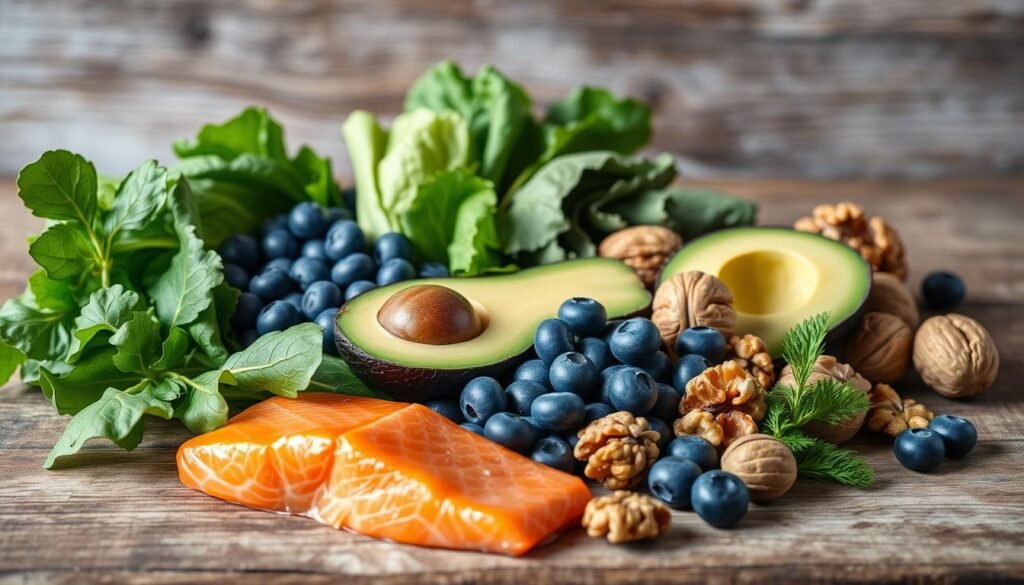Keeping your kidney health in check is key to feeling good. A balanced diet is a big part of this. By choosing the right foods, you can help your kidneys work well.
Thank you for reading this post, don't forget to subscribe!Focus on kidney-friendly foods that are low in sodium, potassium, and phosphorus. A low potassium diet is great for those with kidney issues. It eases the load on these important organs.
By picking the right foods, you can manage your kidney health better. The right diet helps your kidneys function at their best. It also lowers the chance of kidney problems.
Key Takeaways
- Incorporate foods that are low in sodium, potassium, and phosphorus into your diet.
- A well-balanced diet is key for kidney health.
- Smart food choices boost your overall health.
- A low potassium diet is good for those with kidney issues.
- Eating kidney-friendly foods eases the load on your kidneys.
Understanding Kidney Health and Dietary Needs
Keeping your kidneys healthy is key to feeling good. It starts with knowing what kidneys do. They clean waste, balance salts, and control water in your body. This is essential for your health.
The Role of Kidneys in Your Body
Your kidneys are two bean-shaped organs in your lower back. They filter about 200 liters of blood every day. This removes waste and extra stuff. They also keep the right balance of salts like potassium and phosphorus.
Healthy kidneys make hormones too. These hormones help your bones and make red blood cells.
How Diet Impacts Kidney Function
What you eat affects your kidneys. Foods high in sodium, potassium, or phosphorus can be hard on them. This is true for people with kidney problems.
A low potassium diet is often suggested for kidney issues. It helps avoid problems. Eating kidney health foods can also help. These are foods low in sodium and full of antioxidants.
Why Sodium, Potassium, and Phosphorus Matter for Kidney Health
Sodium, potassium, and phosphorus are key minerals for kidney health. Keeping their levels balanced is vital for those wanting to support their kidneys through diet.
The Impact of High Sodium on Kidneys
Too much sodium can raise blood pressure, a big risk for kidney disease. High sodium makes kidneys work harder, leading to strain and damage. Reducing sodium intake is key for kidney health. Choose kidney-friendly meals that are low in sodium.
Potassium Balance and Kidney Function
Potassium helps control fluid balance and blood pressure. But, those with kidney problems may need to watch their potassium. Monitoring potassium levels is important. Eat kidney health foods that are low in potassium to keep balance.
Phosphorus Regulation in Kidney Health
Phosphorus needs careful management for kidney health. If kidneys fail, phosphorus can build up, causing bone and heart problems. Limiting phosphorus intake is important. Choose the right kidney-friendly meals to reduce risks.
| Mineral | Impact on Kidney Health | Dietary Recommendations |
|---|---|---|
| Sodium | High intake can increase blood pressure and strain kidneys. | Reduce sodium intake by choosing low-sodium foods. |
| Potassium | Excess can be harmful if kidneys are damaged. | Monitor potassium levels and consume low-potassium foods. |
| Phosphorus | Buildup can lead to bone and cardiovascular issues. | Limit phosphorus intake by selecting appropriate kidney health foods. |
Signs Your Kidneys Need Dietary Support
If you feel tired, have swelling, or notice changes in how you pee, it might mean your kidneys need help. Your kidneys are key in getting rid of waste and extra water. Eating foods that support kidney health can help them work better.
Common Symptoms of Kidney Stress
Kidney stress can show up in different ways. Some common signs are:
- Swelling in the legs, ankles, or feet due to fluid retention
- Changes in urination patterns, such as frequency or color
- Fatigue or weakness, potentially due to anemia or electrolyte imbalances
- Itching or skin rashes, which can be related to waste buildup
These signs might mean you need to change your diet. This could include eating less potassium or avoiding foods high in sodium.
When to Consult a Healthcare Provider
If you notice any of these symptoms, see a doctor. They can check your health and tell you what diet changes you need. If you already have kidney problems, eating kidney health foods can help.
| Symptom | Possible Cause | Dietary Adjustment |
|---|---|---|
| Swelling | Fluid retention | Reduce sodium intake |
| Fatigue | Anemia or electrolyte imbalance | Increase iron-rich foods, follow a low potassium diet |
| Itching | Waste buildup | Avoid high phosphorus foods |
Choosing the right foods for your kidneys can really help your health. Always talk to a doctor before changing your diet a lot.
Kidney-Friendly Nutrition Principles
Learning about kidney-friendly nutrition helps people make better food choices. A good diet is key for keeping kidneys working well, which is important for those with kidney problems.
Balancing Nutrients for Optimal Kidney Function
It’s important to balance nutrients for kidney health. This means eating the right amounts of sodium, potassium, and phosphorus. A low potassium diet is often suggested for those with kidney issues, as too much potassium can harm the kidneys. Adding kidney friendly meals to your diet can help achieve this balance. These meals should be full of good nutrients but low in harmful ones.
To balance nutrients well, knowing their roles is key. For example, potassium is good for the heart but too much is bad for those with kidney disease. Phosphorus is important for bones, but too much can cause problems for kidney patients.
Reading Food Labels for Kidney Health
Reading food labels is a must for a kidney-friendly diet. You should check the sodium, potassium, and phosphorus in food products. Look for “low sodium” or “low potassium” labels to make smart choices. Knowing how to read labels helps you avoid bad nutrients and choose better foods.
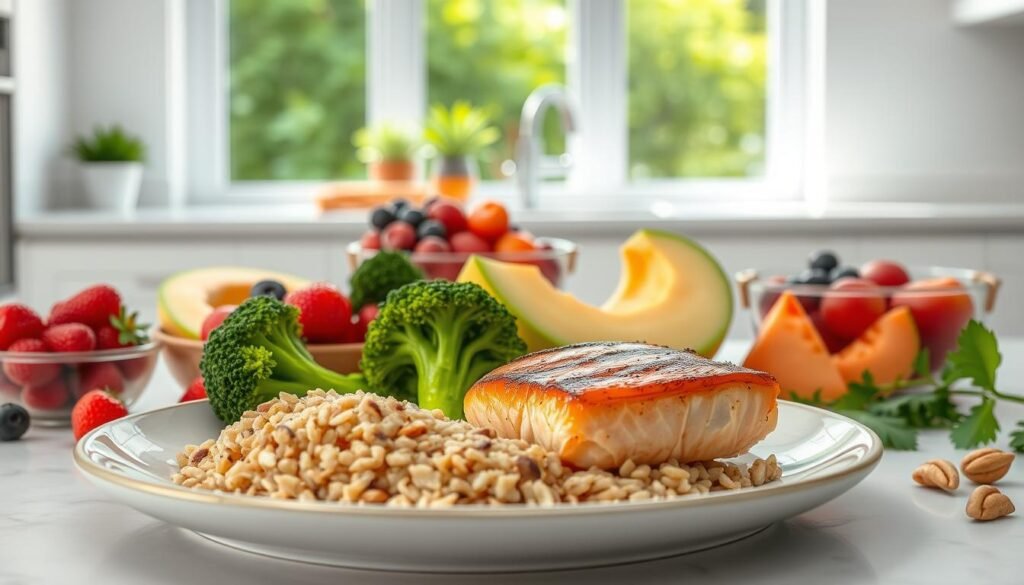
By paying attention to what’s in your food and making smart choices, you can help manage your kidney health. This active approach to eating can greatly improve your overall health.
Egg Whites: A Kidney-Friendly Protein Source
Egg whites are a great choice for those with kidney health issues. They are packed with protein and low in phosphorus, potassium, and sodium. This makes them perfect for people with kidney concerns.
Nutritional Profile and Kidney Benefits
Egg whites are a top-notch protein source. They help keep your muscles strong and your health in check. They have very little phosphorus, potassium, and sodium. This is good news for those with kidney problems.
One large egg white has about 3.6 grams of protein. It’s also almost fat-free.
How to Prepare Egg Whites for Maximum Benefit
It’s easy to prepare egg whites. You can boil, scramble, or make an omelette with them. To get the most out of them, cook without adding too much salt or fat.
Poaching or steaming are great ways to cook them. These methods keep the protein in and don’t add extra sodium.
Simple Egg White Recipes for Kidney Health
Here are some easy recipes to add egg whites to your meals:
- Egg White Omelette: Fill with spinach and bell peppers.
- Poached Egg Whites: Serve with whole grain toast.
- Egg White Scramble: Mix with herbs and lemon juice.
| Nutrient | Amount per Large Egg White |
|---|---|
| Protein | 3.6 grams |
| Phosphorus | 5 mg |
| Potassium | 54 mg |
| Sodium | 55 mg |
Cranberries: Antioxidant-Rich Support for Urinary Health
Cranberries are known for their health benefits, including kidney support. These small fruits are full of nutrients. They help keep the urinary tract healthy, which supports the kidneys.
How Cranberries Benefit the Kidneys
Cranberries have proanthocyanidins that prevent bacteria from sticking to the bladder and urinary tract. This helps avoid urinary tract infections (UTIs). UTIs are common, and cranberries help by keeping the urinary tract healthy. This indirectly helps the kidneys.
Choosing the Best Form: Fresh, Dried, or Juice
Cranberries come in fresh, dried, or juice forms. Fresh ones are full of antioxidants but are very tart. Dried cranberries are easy to eat but might have added sugars. Unsweetened cranberry juice gives you a lot of cranberry benefits in one drink.
Easy Ways to Add Cranberries to Your Diet
It’s easy to add cranberries to your meals. You can mix fresh or dried cranberries into salads, oatmeal, or yogurt. Cranberry juice is great on its own or in recipes. Here are some ideas:
| Form | Usage Ideas |
|---|---|
| Fresh | Salads, baked goods, sauces |
| Dried | Snacking, oatmeal, trail mix |
| Juice | Beverage, smoothies, marinades |
Adding cranberries to your diet helps your kidney health. It’s a step towards kidney friendly meals that are tasty and good for you.
Cabbage: A Versatile Low-Potassium Vegetable
For those watching their potassium, cabbage is a great choice. It’s low in potassium but packed with vitamins and antioxidants. This makes it perfect for a kidney-friendly diet.
Cabbage Varieties and Their Kidney Benefits
Cabbage comes in green, red, and savoy types. Each variety has its own health benefits for the kidneys. Green cabbage is full of fiber and vitamins. Red cabbage is loaded with antioxidants. Savoy cabbage is tender and easy to digest, great for sensitive stomachs.
How to Prepare Cabbage to Reduce Potassium Content
To lower cabbage’s potassium, boil or steam it. Boiling can remove some potassium, so discard the water. Steaming keeps more nutrients in the cabbage.
Kidney-Friendly Cabbage Recipes
Making cabbage part of your diet is easy and tasty. Try a cabbage salad with lemon and herbs. You can also add it to soups or stews. Or sauté it with garlic and olive oil for a tasty side.
Red Bell Peppers: Vitamin C Powerhouse
Red bell peppers add color to meals and are packed with vitamin C. This makes them great for kidney health. They’re a key part of a diet that helps kidneys function well.
Nutritional Benefits for Kidney Function
Red bell peppers are full of vitamin C, an antioxidant that guards the kidneys. Vitamin C also boosts the immune system, which is vital for health, including kidney health. Adding kidney health foods like red bell peppers to your diet is a smart move for your kidneys.
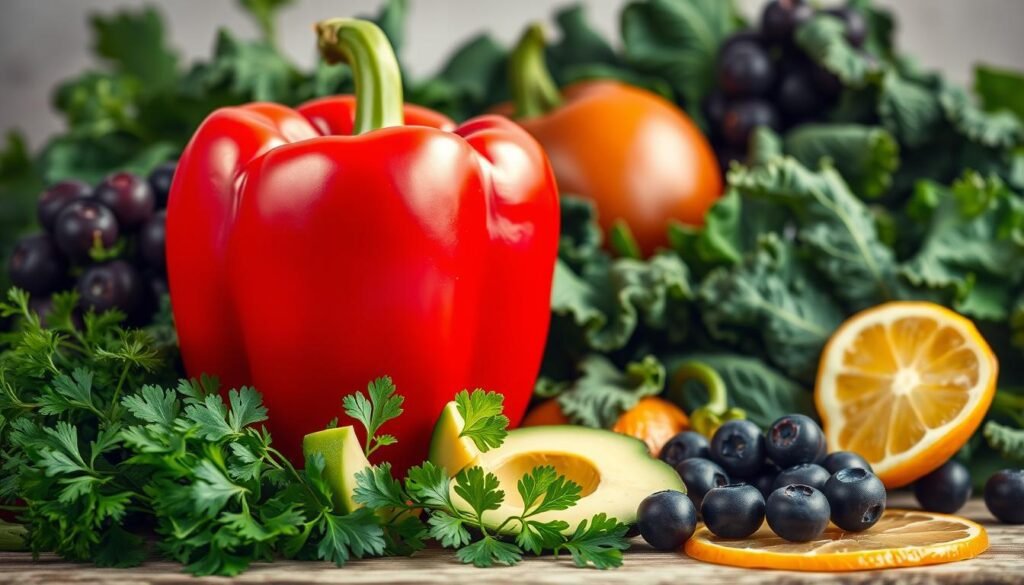
How to Select and Store Bell Peppers
Look for red bell peppers that are firm and shiny. Steer clear of those with soft spots or wrinkles. Keep them in the fridge to stay fresh for up to a week. Storing them right keeps their nutrients intact.
Creative Ways to Include Bell Peppers in Meals
Red bell peppers can be used in many ways: in salads, roasted, or sautéed. Here are some ideas to add them to your meals:
- Add sliced red bell peppers to your favorite salad for a crunchy texture.
- Roast red bell peppers with olive oil and seasonings for a delicious side dish.
- Include red bell peppers in stir-fries for a burst of color and flavor.
Adding red bell peppers to your diet is a tasty way to boost your kidney health.
Garlic and Onions: Flavor Enhancers with Kidney Benefits
Garlic and onions are not just for cooking. They also help keep your kidneys healthy. Adding them to kidney friendly meals boosts taste and nutrition.
Anti-inflammatory Properties for Kidney Protection
Garlic and onions are full of antioxidants. They also have anti-inflammatory effects. These can protect your kidneys from harm.
How to Use Garlic and Onions as Salt Alternatives
Garlic and onions can cut down on salt in your dishes. This is good for your kidneys. Just sauté them at the beginning of your recipe. They add flavor without sodium. Here’s a simple guide to using them:
| Ingredient | Preparation Method | Flavor Profile |
|---|---|---|
| Garlic | Minced and sautéed | Pungent, rich |
| Onions | Chopped and caramelized | Sweet, deep |
Cooking Techniques to Maximize Benefits
Roasting or sautéing garlic and onions boosts their nutritional value. Roasting, for instance, makes them sweeter and more flavorful. They’re perfect for kidney friendly meals.
Cauliflower: A Versatile Low-Potassium Alternative
Cauliflower is a great choice for those watching their potassium intake. It’s low in potassium but packed with vitamins and minerals. Adding cauliflower to your meals can help you stick to a low potassium diet while enjoying different tastes and textures.
Cauliflower is super versatile in the kitchen. You can use it as a pizza crust or mashed potatoes substitute. This makes it perfect for those who want to cut down on potassium without losing flavor.
Cauliflower’s Kidney-Friendly Nutrient Profile
Cauliflower is full of vitamin C, vitamin K, and fiber. It’s also low in potassium, with about 176 mg in a cup of cooked cauliflower. This makes it a great swap for high potassium veggies.
Its nutrient profile is great for kidney health. It provides essential vitamins and minerals without too much potassium. Plus, its fiber helps with digestion, which is good for overall health.
How to Use Cauliflower as a Substitute in High-Potassium Dishes
Cauliflower can be used in many creative ways to replace high potassium ingredients. For instance, blend cooked cauliflower with garlic and olive oil for a low potassium mashed potatoes version. You can also use it as a pizza crust base, a lower potassium option than traditional crusts.
Here’s a table comparing cauliflower’s potassium content to other veggies:
| Vegetable | Potassium Content (mg per cup) |
|---|---|
| Cauliflower (cooked) | 176 |
| Potatoes (mashed) | 748 |
| Spinach (cooked) | 840 |
Simple Cauliflower Recipes for Kidney Health
Here are some easy recipes to start using cauliflower in your diet:
- Cauliflower “Mashed Potatoes”: Blend cooked cauliflower with garlic, olive oil, and a pinch of salt for a delicious and healthy side dish.
- Cauliflower Pizza Crust: Pulse cauliflower in a food processor until it resembles rice, then microwave and mix with cheese and egg to form a crust.
- Roasted Cauliflower: Toss cauliflower florets with olive oil, salt, and your choice of herbs, then roast in the oven until tender and golden.
These recipes show how versatile cauliflower is. They can make a low potassium diet more flavorful and nutritious.
Blueberries: Antioxidant Support for Kidney Health
Blueberries are packed with antioxidants, making them a tasty way to boost kidney health. They are full of nutrients that support overall well-being. Adding them to your diet can be a great step towards kidney health.
How Antioxidants Support Kidney Function
Antioxidants protect the kidneys from damage caused by oxidative stress. Blueberries have anthocyanins, which are strong antioxidants. They help fight off free radicals, supporting kidney health.
Antioxidants in blueberries reduce oxidative stress, helping keep the kidneys working well. This is key for people with kidney issues, as it can slow down kidney disease.
Choosing Between Fresh and Frozen Blueberries
Fresh and frozen blueberries are both good for kidney health. Fresh ones are great for snacks and salads. Frozen blueberries are perfect for smoothies and baking, as freezing keeps their antioxidants.
Choose based on your recipe and what you like. Both fresh and frozen blueberries offer the antioxidants needed for kidney health.
Daily Blueberry Consumption Strategies
It’s easy to add blueberries to your daily meals. Here are some ideas:
- Add fresh or frozen blueberries to your breakfast cereal or oatmeal.
- Blend blueberries into smoothies for a nutritious boost.
- Use blueberries in baking, such as muffins or cakes.
Just a handful (about 1/2 cup) of blueberries a day can give you a big antioxidant boost for your kidneys.
| Nutrient | Benefit for Kidney Health | Amount in 1/2 cup Blueberries |
|---|---|---|
| Antioxidants (Anthocyanins) | Reduces oxidative stress | High |
| Fiber | Supports digestive health | 4 grams |
| Vitamin C | Boosts immune function | 11 mg |
Olive Oil: Heart-Healthy Fat for Kidney Support
Olive oil is great for your heart and kidneys. It helps keep both systems working well together. Adding olive oil to your meals can help support your heart and kidneys.
The Connection Between Heart and Kidney Health
The heart and kidneys are closely connected. The heart sends blood to the kidneys for filtering. The kidneys help control blood pressure, which is good for the heart. Eating heart-healthy fats like olive oil is key to keeping both healthy.
How to Select and Store Quality Olive Oil
Choosing the right olive oil is important. Look for extra virgin olive oil that’s cold-pressed and certified. Keep it in a cool, dark spot to keep its nutrients. This way, you can enjoy its taste and benefits in kidney friendly meals.
Healthy Cooking Methods Using Olive Oil
Olive oil is great for cooking. It’s good for sautéing and making salad dressings. It has a high smoke point, so it’s safe for cooking at moderate heat. Using olive oil can make your meals taste better and support your heart and kidneys. Try adding it to your kidney friendly meals for extra flavor and nutrition.
| Cooking Method | Benefits |
|---|---|
| Sautéing | Quickly cooks vegetables while preserving nutrients |
| Making Salad Dressings | Adds flavor without needing processed ingredients |
| Baking | Can be used as a healthier alternative to butter or other oils |
Arugula: Low-Potassium Leafy Green Option
Arugula is a great choice for those watching their potassium intake. It’s packed with nutrients and adds flavor to many dishes. It supports kidney health and can be easily added to your meals.
Nutritional Benefits for Kidney Health
Arugula is full of vitamins A, C, and K, and has calcium and potassium. Its potassium is lower than spinach, but it’s rich in antioxidants. These compounds protect the kidneys and may help slow kidney disease.
Incorporating Arugula as a Spinach Alternative
Arugula is a good swap for spinach on a low-potassium diet. Use it in salads, sauté it, or add it to soups. Replacing high-potassium foods with arugula helps control potassium levels. Briefly boiling and draining arugula can lower its potassium, but it might lose some nutrients.
Fresh Arugula Recipes for Kidney Support
Here are tasty ways to use arugula: – Make an arugula salad with grilled chicken and lemon vinaigrette. – Saute arugula with garlic as a side. – Add arugula to omelets or frittatas. – Mix it into pasta for a nutritional boost. These recipes are not only delicious but also support kidney health. They provide important nutrients while keeping potassium levels balanced.
| Nutrient | Amount per 1 cup Arugula | % Daily Value |
|---|---|---|
| Potassium | 74mg | 2% |
| Vitamin A | 1190 IU | 24% |
| Vitamin C | 4.3mg | 7% |
| Calcium | 32mg | 3% |
Pineapple: Natural Anti-Inflammatory for Kidneys
Pineapple is great for keeping your kidneys healthy. It has an enzyme called bromelain. This enzyme helps reduce body inflammation.
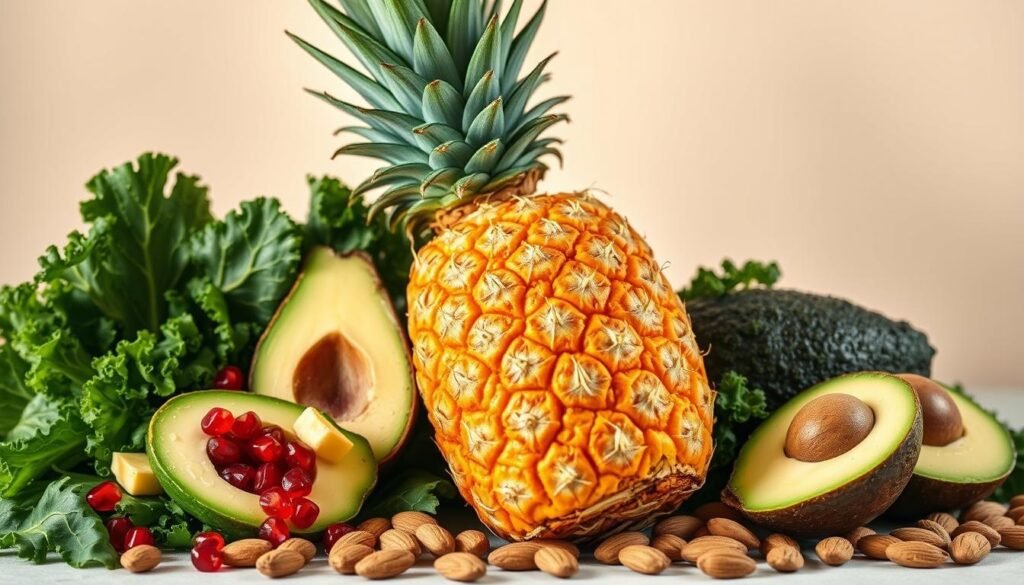
How Pineapple Enzymes Support Kidney Function
Bromelain in pineapple fights inflammation that can harm kidneys. It keeps kidneys healthy. Eating pineapple can be a tasty way to help your kidneys.
Proper Portions for Kidney-Friendly Consumption
It’s good to eat pineapple but in small amounts, if you have kidney problems. A 1-cup serving of pineapple chunks is safe. Watching your portion sizes is key to a balanced diet for your kidneys.
| Food Item | Serving Size | Potassium Content |
|---|---|---|
| Pineapple | 1 cup chunks | 133 mg |
| Fresh Pineapple Juice | 1 cup | 195 mg |
| Dried Pineapple | 1/4 cup | 113 mg |
Delicious Ways to Enjoy Pineapple Safely
Pineapple is versatile for kidney health. You can mix it in fruit salads, smoothies, or eat it as a snack. Remember to keep your serving size in check to avoid too much potassium. Here are some ideas:
- Add pineapple chunks to your oatmeal or yogurt.
- Blend pineapple with other fruits for a smoothie.
- Use pineapple as a topping for salads or desserts.
By eating pineapple in the right amounts, you can use its anti-inflammatory benefits for your kidneys.
Creating Kidney Friendly Meals, Low Potassium Diet, and Kidney Health Foods
Making kidney-friendly meals is key to managing kidney health. It’s easy and tasty with the right approach. A good diet keeps your kidneys working well and boosts your overall health. Let’s look at how to make meals that are good for your kidneys and fun to eat.
Weekly Meal Planning Strategies for Kidney Health
Good meal planning is the base of a kidney-friendly diet. It means knowing what your body needs and planning meals that fit those needs but avoid bad stuff. First, figure out what nutrients you need to watch, like sodium, potassium, and phosphorus. Then, plan your meals for the week with foods that are good for your kidneys, like veggies, fruits, lean proteins, and whole grains.
Batch cooking and making meals ahead of time can help. It saves time and makes sure you have healthy food ready when you need it. You can also use a meal planning app or talk to a dietitian for personalized tips on making kidney-friendly meals.
Sample 3-Day Meal Plans for Different Kidney Conditions
Meal plans vary for different kidney conditions. Here are some 3-day meal plans for different needs:
- For CKD Stage 3: Eat low potassium foods like apples, berries, and cauliflower. Choose lean proteins like chicken and fish.
- For CKD Stage 4: Focus on low phosphorus foods and cut down on dairy. Use egg whites as a protein source.
- For dialysis patients: Increase protein with lean meats, eggs, and tofu. Watch your fluid intake.
These plans should be adjusted based on your specific needs and health. Always talk to a healthcare provider or a renal dietitian to make a meal plan that’s right for you.
Batch Cooking and Preparation Tips
Batch cooking is a smart way to make kidney-friendly meals ahead of time. It means cooking big batches of food that you can portion out and freeze for later. Here are some tips for batch cooking:
- Choose recipes that are easy to make in large quantities and can be stored.
- Prepare ingredients ahead of time, like chopping veggies or marinating proteins.
- Use airtight containers to store meals and label them with dates.
Batch cooking helps save time, cuts down on waste, and makes sure you always have healthy meals ready.
Foods to Limit or Avoid for Kidney Health
To keep your kidneys healthy, it’s key to know which foods to limit. Eating the right foods helps your kidneys work well. But, too much sodium, potassium, and phosphorus can harm them.
High-Sodium Foods and Better Alternatives
High-sodium foods can raise blood pressure, stressing your kidneys. Processed meats, canned goods, and some condiments are high in sodium. Instead, choose fresh meats, make your own sauces, and use low-sodium condiments.
Using herbs and spices can add flavor without sodium. This makes for kidney friendly meals.
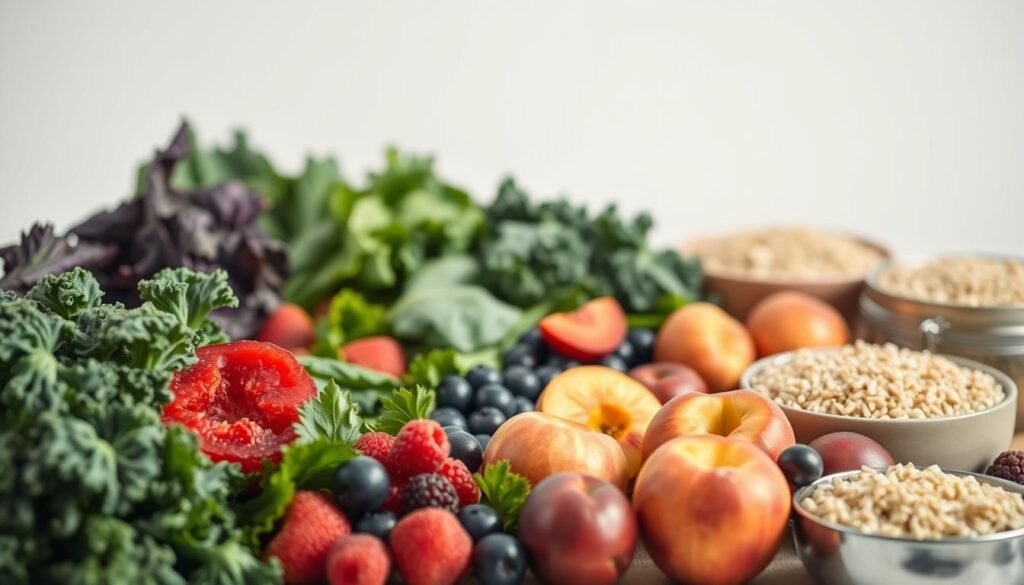
High-Potassium Foods and Safer Substitutes
Foods like bananas, avocados, and leafy greens have too much potassium for people with kidney issues. Better choices include berries and citrus fruits, which have less potassium. Cooking veggies can also lower their potassium, which is good for a low potassium diet.
Hidden Phosphorus Sources and How to Avoid Them
Phosphorus is often found in processed foods, making it a hidden risk. Processed meats, flavored coffees, and some baked goods have phosphorus. To avoid too much phosphorus, read labels and choose whole, unprocessed foods. This helps keep your kidneys healthy.
Conclusion
Supporting kidney health through diet is a smart move for your overall health. The foods we eat greatly affect our kidney function. Eating kidney-friendly foods can protect your kidneys from harm.
Choosing the right foods is key to keeping your kidneys healthy. Foods low in sodium, potassium, and phosphorus are good for your kidneys. Making smart food choices can help protect your kidney health.
Adopting a kidney-friendly diet is more than just cutting out certain foods. It’s about making healthy choices that boost your overall health. With the right advice and a commitment to healthy eating, you can support your kidney health. Start today by adding kidney-friendly foods to your meals and see the positive effects on your well-being.
FAQ
What are some kidney-friendly foods that are low in potassium?
Foods like cabbage, cauliflower, and arugula are tasty and low in potassium. They’re great for a kidney-friendly diet. Adding them to your meals can help your kidneys stay healthy.
How can I reduce the potassium content in vegetables like cabbage?
To lower potassium in veggies, try leaching. Slice or dice them, then soak in water before cooking. This method can make them safer for a low-potassium diet.
Are egg whites a good protein source for kidney health?
Yes, egg whites are a top choice for kidney health. They’re low in phosphorus and potassium. You can scramble or make omelets with them to add protein without extra minerals.
Can cranberries really support urinary and kidney health?
Cranberries are full of antioxidants and may help prevent urinary tract infections. They might also support kidney health. Enjoy them fresh, dried, or as juice, but watch out for added sugars.
How does olive oil benefit kidney health?
Olive oil is full of healthy fats that are good for your heart. This can help your kidneys too. Use it for cooking or dressing, but eat it in small amounts because it’s high in calories.
What are some tips for meal planning on a kidney-friendly diet?
Good meal planning for kidney health means balancing nutrients and watching sodium, potassium, and phosphorus. Eat veggies, fruits, and lean proteins that are low in these. Get advice from a dietitian or healthcare provider for your specific needs.
Are there any specific foods I should avoid for kidney health?
Yes, avoid foods high in sodium, potassium, and phosphorus. This includes processed foods, some dairy, and foods with added phosphates. Choose fresh, whole foods and read labels carefully to make better choices.
How can I incorporate blueberries into my diet for kidney health?
Blueberries are packed with antioxidants that support health, including the kidneys. Enjoy them fresh, frozen, or dried. Add them to oatmeal, yogurt, or salads. Just remember to eat them in moderation.
Can garlic and onions really provide kidney benefits?
Garlic and onions have anti-inflammatory effects that might protect the kidneys. They also add flavor without salt, which is good for a low-sodium diet. Use them in your cooking to flavor your food and possibly support kidney health.
What are some simple ways to prepare kidney-friendly meals?
Making kidney-friendly meals is easy. Grill, roast, or sauté with olive oil. Use herbs and spices for flavor instead of salt. Include veggies, lean proteins, and whole grains in your meals for a balanced diet.
